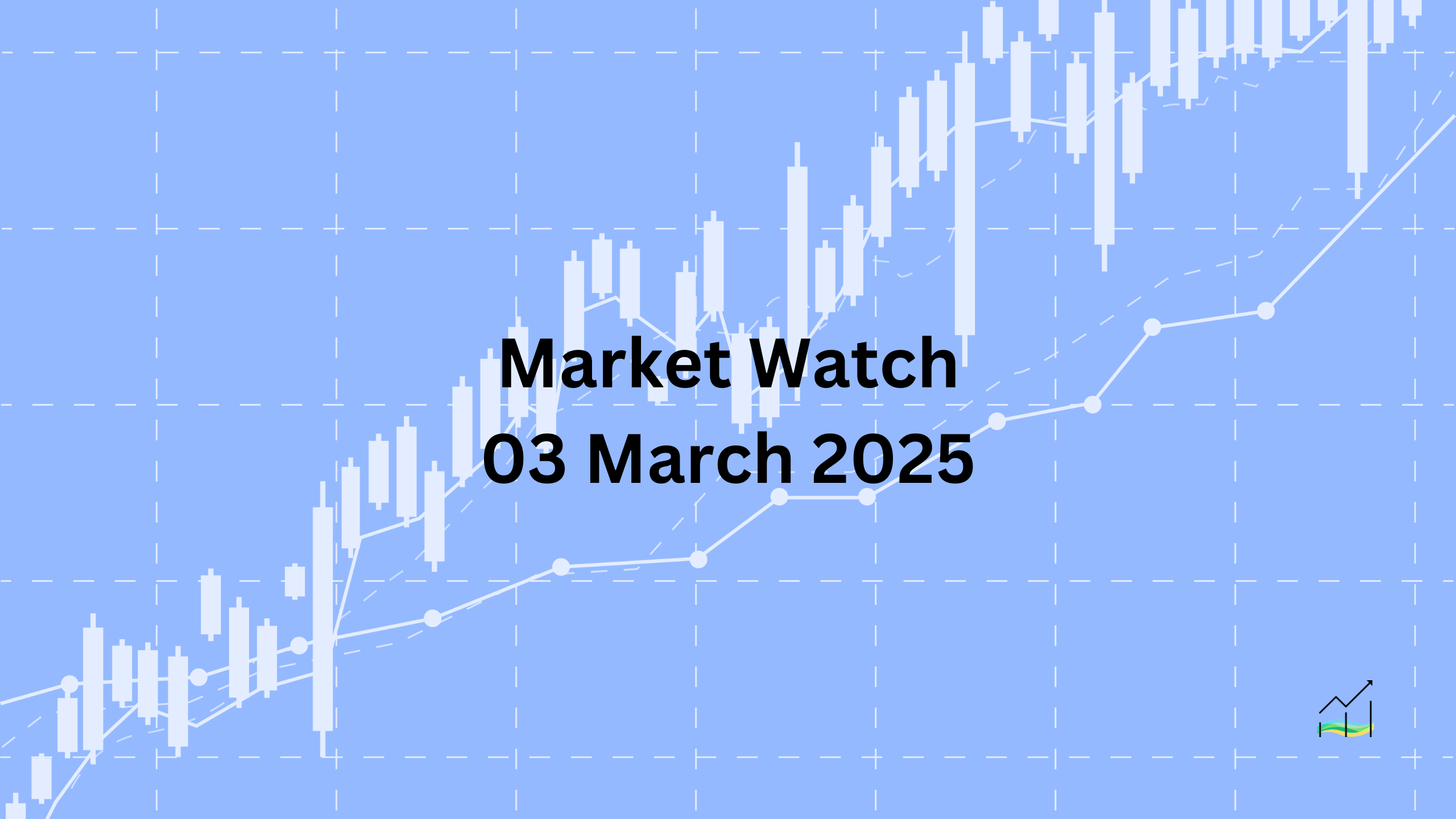03/03/2025 Market Watch

Dollar's Rally, Tariffs & Global Trends
The US dollar strengthened in the latter half of last week, even as interest rates declined due to renewed concerns over economic growth. The potential implementation of delayed tariffs—25% on Canadian goods (10% on energy) and similar measures on Mexico—could take effect as soon as tomorrow. Meanwhile, the only tariffs enforced so far have been 10% on Chinese imports, with another round expected tomorrow and possibly in April. The ongoing tariff policies and uncertainties are contributing to economic disruptions, making them a growing concern for markets.
Despite last week's rally, the dollar is currently weaker against all G10 currencies. European currencies are leading the move higher, supported by rising interest rates and stronger stock markets. Emerging market currencies, particularly those in central Europe, are also showing strength.
In equities, the Asia-Pacific region saw mixed performance. Japan, Hong Kong, and Australia posted gains, while China and Taiwan declined. In Europe, the Stoxx 600 has been on an impressive ten-week rally, up 10.25% for the year and continuing its upward trend today. US stock futures are extending the strong rebound seen before the weekend.
In the bond market, yields in Europe have climbed 4-7 basis points, while the US 10-year Treasury yield has risen nearly five basis points to 4.25%. Commodities saw significant movement as well—gold fell 2.7% last week, marking its first weekly decline of the year, though it has rebounded 0.5% today, hovering near $2,872. Crude oil initially climbed, with April WTI hitting a three-day high of $70.60 before reversing lower toward $69.15.
United States of America
Overview
The Dollar Index is reversing its three-day, 1.5% advance, with renewed attention on US tariffs. Potential tariff hikes on Canadian, Mexican, and Chinese goods have supported the dollar’s recent strength, even as yields declined late last week. However, today’s trading sees the dollar under pressure, failing to recover from early losses in Asia.
Economic Drivers
US growth concerns are intensifying. The Atlanta Fed slashed its Q1 GDP forecast from 2.4% in mid-February to -1.5%, signaling a sharp deterioration in expectations. Consumer spending data also raised alarms, with real personal spending plunging 0.5% in January—the steepest drop since early 2021. Poor weather likely contributed to weak January data, but the broader economic slowdown remains a growing risk.
Data and Events
Key economic indicators this week could shift market sentiment. The manufacturing PMI and ISM are expected to remain above the 50 boom-or-bust level, providing some stability. Meanwhile, auto sales are likely to rebound after a sharp 7.1% drop in January. The most significant event will be Friday’s employment report, with job growth expected to align with January’s figures. While signs of economic weakness are emerging, the deterioration still appears gradual.
Price Action
The Dollar Index recently settled above its 20-day moving average for the first time in three weeks, briefly testing the 38.2% retracement level from its January 13 peak. The next retracement (50%) is near 108.15, but today’s session has seen the dollar marked lower. Key support may be found near 160.75.
Key Points:
- The Dollar Index is reversing recent gains despite tariff concerns.
- US growth outlook worsened, with the Atlanta Fed cutting its Q1 GDP estimate to -1.5%.
- January personal spending saw its biggest drop in nearly three years.
- Manufacturing PMI, ISM, and auto sales data may help stabilize sentiment.
- Friday’s employment report will be a key event, with job growth expected to hold steady.
Australia
Overview
The Australian dollar remains under pressure, extending its decline for six consecutive sessions and eight of the last ten. Recent losses have pushed it beyond the 61.8% retracement level from its February 3 rally, briefly dropping below $0.6090. Late last week, it hovered around $0.6200 before closing at its lowest level since January 17. The new week begins with a steadier tone, though movement remains within a narrow range above $0.6200.
Economic Drivers
Technical indicators suggest further downside risk. The five-day moving average has fallen below the 20-day moving average, signaling weakening momentum. Meanwhile, Australia’s manufacturing PMI, which had been below 50 for over a year until January, was confirmed at 50.4 for February. Although lower than the initial estimate of 50.6, this marks its highest level since November 2022, showing signs of improvement in the sector.
Data and Events
This week’s economic calendar is packed with key data releases, which could influence the Australian dollar’s trajectory. Markets will be watching trade figures, retail sales, and the minutes from the Reserve Bank of Australia’s (RBA) February meeting. The highlight will be the first estimate of Q4 GDP, with expectations pointing to 0.5% quarter-over-quarter growth, up from 0.3% in Q3.
Price Action
The Australian dollar’s recent weakness has been driven by technical and fundamental factors. It remains in a tight trading range above $0.6200, with momentum indicators suggesting continued downward pressure. Traders will be looking at upcoming data to determine if the currency can stabilize or extend its losses further.
Key Points:
- The Australian dollar has fallen for six straight sessions, testing key retracement levels.
- The five-day moving average dropped below the 20-day moving average, signaling bearish momentum.
- Manufacturing PMI confirmed at 50.4, marking its second consecutive month above 50.
- Key economic releases this week include trade data, retail sales, RBA minutes, and Q4 GDP.
- GDP is expected to grow 0.5% in Q4, up from 0.3% in the previous quarter.
Canada
Overview
The US dollar has been on a strong run, advancing for six consecutive sessions and rising in nine of the past ten. Tariff threats have been a key driver, supporting the greenback’s recovery despite potential risks ahead. The US dollar is currently holding above CAD1.4200 after reaching CAD1.4470, the 50% retracement level from its February 3 decline. The next technical level is CAD1.4550, representing the 61.8% retracement.
Economic Drivers
US tariff threats remain the most significant factor influencing the Canadian economy and monetary policy. Even before any tariffs are implemented, the market reaction has been notable, affecting sentiment and expectations. The Canadian dollar's weakness reflects these concerns, with traders closely monitoring tariff developments.
Data and Events
Canada’s February manufacturing PMI will be released today. In January, it fell to 51.6, ending a five-month streak of gains and hitting a three-month low. Later in the week, the focus shifts to Canada’s employment report on Friday, where the unemployment rate is expected to rise to 6.7%, up from November’s cyclical peak of 6.9%.
Price Action
The US dollar’s recovery has been technically supported, with momentum indicators still constructive. The five-day moving average has crossed above the 20-day moving average, reinforcing the bullish trend. However, with key data releases and ongoing tariff developments, the dollar’s rally could face challenges.
Key Points:
- The US dollar has advanced in nine of the past ten sessions, supported by tariff concerns.
- It is holding above CAD1.4200, with resistance at CAD1.4470 and CAD1.4550.
- US tariff threats remain the primary driver of sentiment in Canadian markets.
- Canada’s manufacturing PMI and employment report are key data points this week.
- The unemployment rate is expected to tick up to 6.7%, adding further pressure on the Canadian dollar.
China
Overview
The US dollar has rebounded against the Chinese yuan after finding support near the 200-day moving average (CNH7.2220) last Monday. It climbed to CNH7.30 before the weekend and has extended gains to CNH7.3060 today. The next technical targets are near CNH7.3170 and CNH7.3250.
Economic Drivers
The People's Bank of China's (PBOC) reference rate for the dollar edged higher last week, providing the greenback with more room to appreciate. Today’s fix was set at CNY7.1745, the highest level since January 20. This indicates that authorities are allowing some depreciation in the yuan, supporting the dollar’s upward momentum.
Data and Events
China's February PMI data showed a slight improvement. The official manufacturing PMI rose to 50.2 from 49.1, while the non-manufacturing PMI increased to 50.4 from 50.2. The composite PMI reached 51.1, compared to 50.1 previously. Additionally, the Caixin manufacturing PMI climbed to 50.8 from 50.1, reinforcing signs of stabilization in China’s economic activity.
Price Action
The dollar’s technical outlook remains positive after bouncing from key support levels. With the PBOC’s fix rising and economic data showing gradual improvement, further upside movement toward CNH7.3170 and CNH7.3250 remains in focus.
Key Points:
- The US dollar has strengthened against the yuan after rebounding from the 200-day moving average.
- The PBOC's reference rate for the dollar has risen, allowing for further appreciation.
- China’s February PMI data showed modest improvement, signaling economic stabilization.
- The next technical resistance levels for the dollar are CNH7.3170 and CNH7.3250.
Europe
Overview
The euro fell to $1.0360 before the weekend after failing to hold gains near $1.0530 earlier in the week. It moved past the 38.2% retracement level of its rally from the February 3 low, found near $1.0380, with the next support at $1.0335. Despite downward momentum, the euro has found buyers today, with resistance seen in the $1.0450-65 zone.
Economic Drivers
Eurozone inflation slowed in February, with CPI rising 0.5% month-over-month. Due to base effects from last year’s 0.6% rise, the annual rate eased to 2.4% from 2.5%—its first decline in five months. With inflation expected to continue softening through April, the European Central Bank (ECB) remains on track to cut rates, reinforcing market expectations.
Data and Events
The ECB will release updated economic projections this Thursday, following its December forecast that inflation would decline to 2.1% this year. This aligns with Bloomberg’s median forecast. Additionally, February’s final manufacturing PMI was revised higher to 47.6 from the initial 47.3 estimate, showing slight improvement from January’s 46.6 reading.
Price Action
The euro’s recent drop extended below key support levels, but buyers have re-emerged. Technical indicators suggest further downside risks, with the next retracement target at $1.0335. The $1.0450-65 zone may act as near-term resistance.
Key Points:
- The euro fell to $1.0360 but found some support today.
- The 38.2% retracement was broken, with the next target at $1.0335.
- Eurozone inflation eased to 2.4%, reinforcing ECB rate cut expectations.
- The ECB will release updated forecasts this week, aligning with prior projections.
- Manufacturing PMI improved slightly but remains below 50.
Japan
Overview
The dollar climbed to a six-day high against the yen, approaching JPY151.00 before the weekend, despite falling US rates. It is consolidating around JPY150.00 today, with technical patterns suggesting a rounded bottom near JPY148.50.
Economic Drivers
Japan’s economic data remains weak, with the manufacturing PMI slightly improving to 49.0 from 48.9. However, it remains below the 50.0 threshold, indicating continued contraction. The last time the index was above 50 was in June 2024.
Data and Events
Japan will release its January employment data tomorrow, with expectations of stability compared to the previous month. This report will provide further insight into the labor market's resilience amid broader economic challenges.
Price Action
The dollar has found support near JPY148.50 and is now testing resistance around JPY151.50. A break above this level could target JPY152.50, which aligns with the 38.2% retracement of the decline from January’s peak near JPY158.85 and the 200-day moving average.
Key Points:
- The dollar rose to a six-day high against the yen, nearing JPY151.00.
- Japan’s manufacturing PMI edged up to 49.0 but remains in contraction.
- Japan's January employment data is due tomorrow, expected to remain steady.
- The dollar’s technical support is near JPY148.50, with resistance at JPY151.50 and JPY152.50.
United Kingdom
Overview
Sterling reached a two-month high of $1.2715 last Wednesday, fueled by positive news surrounding Prime Minister Starmer's visit and potential exemptions from US tariffs. However, despite these developments, the currency faced selling pressure and dropped to $1.2560 by the weekend, settling slightly above the 20-day moving average. It began this week on a positive note, pushing above $1.2650.
Economic Drivers
The UK economy shows signs of steady consumer activity, with firm consumer credit and stable mortgage approvals. However, concerns persist in the manufacturing sector, as the final manufacturing PMI was revised to 46.9, a slight improvement from the initial estimate of 46.4, but still below the neutral 50.0 level.
Data and Events
The final UK manufacturing PMI showed marginal improvement but remains in contraction territory, highlighting ongoing challenges in the sector. Consumer credit and mortgage approvals data provide some optimism for the broader economy, indicating steady demand in these areas.
Price Action
Sterling faced resistance at $1.2715 last week and has since fallen to a two-week low of $1.2560. The next technical target for the downside is near $1.2480, the 38.2% retracement of the recovery from the January low. As the week progresses, sterling has shown resilience, moving above $1.2650, with resistance potentially encountered around $1.2560-$1.2575.
Key Points:
- Sterling peaked near $1.2715, its best level in two months, before falling to $1.2560.
- Positive UK consumer credit and mortgage approval data offset concerns in manufacturing.
- The final manufacturing PMI was revised to 46.9, indicating continued contraction in the sector.
- Sterling has support near $1.2480 and resistance around $1.2560-$1.2575.
© 2025 SKONE Enterprise (003319453-V). All rights reserved.
The content on this site is for informational purposes only and does not constitute financial advice.


